This site uses cookies as defined in our Cookie Policy, by continuing to use this site you agree to their use.
Continue
Set sail from Fort Lauderdale, for a 29-day, return voyage with a distinctly Latin American flavour! Heading for the colourful, mosaic of islands that make up the Caribbean, enjoy the individual flavours of each one from chic St Barts to the shell sands of Grand Turk. Passage of the legendary Panama Canal leads to Puntarenas, Costa Rica and the diverse and spectacular cultures of Guatemala and Mexico. Mix in blissful sea days and you truly have it all!
| Arrive | Depart | ||||||
| 21st21 | MarMar | 202525 | Bridgetown, Barbados, embark on the Silver Moon | 23:00 | |||
Located beside the island’s only natural harbour, the capital of Barbados combines modern and colonial architecture with glorious palm tree-lined beaches and a number of historical attractions. Experience the relaxed culture of the city renowned for its British-style parliament buildings and vibrant beach life, and seek out the Anglican church and the 19th-century Barbados Garrison. The distance between the ship and your tour vehicle may vary. This distance is not included in the excursion grades. Bridgetown, the captivating capital of Barbados, combines faded colonial history, captivating tradition, and vivid white beaches plucked directly from your richest imagination of Caribbean perfection. Recently listed as a UNESCO World Heritage site, thanks to its beautifully preserved colonial architecture, Bridgetown’s mask of modernity covers a core of complex history and fascinating culture. Sherbet coloured buildings line up to overlook the waterfront of the Constitution River at the ‘The Careenage’ - where gleaming ships bob on the blue water, and peaceful strolls along a wooden boardwalk await. Stop for a sobering moment at the commemorative plaque honouring the people traded at this spot, when Bridgetown was the British Empire’s most important harbour, and first stop on the Transatlantic Slave Trade crossing. Just five minutes’ stroll from here is Carlisle Bay - a postcard-perfect place where you'll find crystal-clear, turquoise seawater glowing in the Caribbean sun, and a mile of soft white powder sand. A treasure trove for divers, the shipwrecks scattered below the shallow water’s waves are now inhabited by turtles and swirling, rainbow-coloured tropical fish. Head to the backstreets, where street food vendors serve up spicy chicken soup, barbecued pigtails and thirst-quenching coconut water. There are bargains aplenty to be had on Broad Street, where duty-free malls and souvenir stalls cram together, vying for your attention. Roebuck Street is the spot where one of the Caribbean’s favourite drinks, rum, was discovered - having been created here from the by-products of the island’s booming sugarcane trade. Nowadays, it’s lined with bars splashing every variety of the deliciously spicy dark libation imaginable into glasses. For a touch more culture, visit one of the oldest synagogues in The Americas - Nidhe Israel Synagogue, which was built in 1654. The adjoining museum tells the story of Barbados’ Jewish immigrants, who were instrumental in the island’s development. | |||||||
| 22nd22 | MarMar | 202525 | Port Elizabeth, Bequia, Saint Vincent and the Grenadines | 08:00 | 23:00 | ||
Bequia is a Carib word meaning "island of the cloud." Hilly and green with several golden-sand beaches, Bequia is 9 miles (14½ km) south of St. Vincent's southwestern shore; with a population of 5,000, it's the largest of the Grenadines. Although boatbuilding, whaling, and fishing have been the predominant industries here for generations, sailing has now become almost synonymous with Bequia. Admiralty Bay is a favored anchorage for both privately owned and chartered yachts. Lodgings range from comfortable resorts and villas to cozy West Indian—style inns. Bequia's airport and the frequent ferry service from St. Vincent make this a favorite destination for day-trippers, as well. The ferry docks in Port Elizabeth, a tiny town with waterfront bars, restaurants, and shops where you can buy handmade souvenirs—including the exquisitely detailed model sailboats that are a famous Bequia export. The Easter Regatta is held during the four-day Easter weekend, when revelers gather to watch boat races and celebrate the island's seafaring traditions with food, music, dancing, and competitive games.To see the views, villages, beaches, and boatbuilding sites around Bequia, hire a taxi at the jetty in Port Elizabeth. Several usually line up under the almond trees to meet each ferry from St. Vincent. An almost mythical utopia of virgin beaches, rustic rum shacks and bays so scenic you feel like you’re intruding - Bequia Island is an island mirage of Caribbean perfection. This is the real, unspoiled experience - and with just 6,000 locals living here, you quickly start to recognise the same smiling faces, welcoming you with outstretched arms. Offering glorious - often deserted - beaches of pure golden sand, and hillside sweeps of forest and almond trees, Bequia Island is an extraordinary feast for the senses. Unlike some of the flashier Caribbean islands, Bequia - a part of the Grenadines - is a rustic, unassuming and off-the-beaten-path choice. The staggeringly picturesque natural harbour, Admiralty Bay, greets you on arrival, and is peppered with day-tripping yachts bobbing on the gentle waves. The island’s tiny capital, Port Elizabeth, sits behind, with its bustling fruit and vegetable market, turtle sanctuary, and stalls selling hand-crafted model ships. This tiny, pretty island is ridged along the centre, and you can earn your beachside bliss with a gentle hike to the top of Mount Peggy, looking out over views of Grenada and St Vincent. At just seven miles long, you can discover the whole island in a few hours – but that would be to miss the point somewhat. Bequia Island coaxes you in to slow the pace and soothe your soul on blissful beaches, where you can revel in the uncomplicated joys of sitting, reading and swimming in heavenly shallow waters. The royally approved Princess Margaret Beach is one of the finest - an arching band of soft sand and cobalt-blue waters. As evening sets in, you may find you’re beckoned to share with communal barbecues of the day’s fresh catch with the locals, or to indulge in rum-heavy cocktails at beachside bars, lashed together from sea-blanched wooden limbs. | |||||||
| 23rd23 | MarMar | 202525 | Castries, Saint Lucia | 08:00 | 23:00 | ||
The typical image of a lush tropical paradise comes to life on the friendly island of St Lucia. Despite its small size – just 27 miles long and 14 miles wide – St Lucia is rich in natural splendour with dense emerald rainforest, banana plantations and orchards of coconut, mango and papaya trees. The twin peaks of Les Pitons, now a UNESCO World Heritage Site rise dramatically 2,000 feet into the sky and dominate the island. Look out for unusual birds with brilliant plumage such as the St Lucia parrot, see a surprising diversity of exotic flora and enjoy the warm hospitality of the islanders in the small villages and open-air markets. Please be aware that St Lucia is a small, mountainous island, with steep, winding and bumpy roads. Customers with back and neck problems should take this into consideration when booking an excursion. Explore a land of vibrant colour, from the tranquil turquoise water that surrounds it, to the verdant green peaks of its famous soaring volcanic plugs - The Pitons; which give this mesmerising island its form. Waterfalls thunder in the jungled interior, should you successfully drag yourself from St Lucia's gleaming beaches and dive spots - where patchworks of colourful fish dance below the waves. Offering the picturesque island luxury of your wildest dreams, St. Lucia is a cinematic, thrilling Caribbean idyl. Marigot Bay served as the tropical backdrop for 1967’s Doctor Dolittle film, and the island's amiable animal life is never too far away - spot flashes of bright red, as parrots zip between palm trees, before catching sight of dolphins splashing playfully offshore. Vigie beach is a charmed spot to lie back and recline in the sun’s glow, watching as overlapping layers of mesmerising blue hues intertwine. St. Lucia’s iconic Pitons mountains deliver as the perfect backdrop to any envy generating photograph - rising up exponentially from the calm waters like sharp shark fins. Castries is this heavenly island’s capital, and while the Cathedral Basilica of the Immaculate Conception may seem a little humble from the outside, the soft sounds of soulful hymns emanating from within are sure to draw you in. The astonishing interior glows with bright frescoes, lit up by the sunlight that spills inside, and atmospheric rows of flickering candles. There's more rich Caribbean colour to behold at the ramshackle Castries Market, where you can take handfuls of fragrant spices, like nutmeg and cinnamon, and enjoy the singsong ritual of bartering, as you move between tables heaving under bounties of green bananas and rosy mangos. | |||||||
| 24th24 | MarMar | 202525 | Fort-de-France, Martinique | 08:00 | 17:00 | ||
The largest of the Windward Islands, Martinique is 4,261 mi (6,817 km) from Paris, but its spirit and language are decidedly French, with more than a soupçon of West Indian spice. Tangible, edible evidence of the fact is the island's cuisine, a superb blend of French and creole. Martinique is lushly landscaped with tropical flowers. Trees bend under the weight of fruits such as mangoes, papayas, lemons, limes, and bright-red West Indian cherries. Acres of banana plantations, pineapple fields, and waving sugarcane stretch to the horizon. The towering mountains and verdant rain forest in the north lure hikers, while underwater sights and sunken treasures attract snorkelers and scuba divers. Martinique is also wonderful if your idea of exercise is turning over every 10 minutes to get an even tan and your taste in adventure runs to duty-free shopping. A popular cruise-ship excursion goes to St-Pierre, which was buried by ash when Mont Pelée erupted in 1902. With its heady mix of Creole culture and French sophistication, there is more than a pinch of je ne sais quoi in Fort de France. The capital of Martinique, and by far the biggest city in the whole of the French West Indies, if you are looking for Paris in the Caribbean, you’ll find it in Fort de France. The island has been under French govern since 1638 when the first governor of Martinique Jacques Dyel du Parquet commissioned a fort (from which the city takes its name) to keep out invaders. Not even an unsuccessful attack by the British in 1720, nor the French Revolution in 1789, has been able to shake the French govern of the island and today the city’s French and Creole heritage are impossible to untangle. The colonial past is everywhere, take a stroll down the narrow streets and enjoy the remarkable architecture of the Schœlcher Library, St. Louis Cathedral and the Old Town Hall. Among the many legacies Dyel du Parquet left on the island is sugarcane. A drive through the tropical forests will not only reward you with trees bending under the weight of papayas, mangoes and bananas, but will also afford superb vistas of the elegant plant swaying in the breeze. The arrival and subsequent export of sugar brought the French bourgeoisie in their droves and many of their mansions are still standing. Josephine de Beauharnais, the Napoleonic Empress of “not tonight” fame, hails from the island and those interested will find her childhood home, La Pagerie in nearby Trois Ilets. | |||||||
| 25th25 | MarMar | 202525 | Philipsburg, Sint Maarten (Dutch part) | 12:00 | 23:00 | ||
The capital of Dutch St. Maarten stretches about a mile (1½ km) along an isthmus between Great Bay and the Salt Pond and has five parallel streets. Most of the village's dozens of shops and restaurants are on Front Street, narrow and cobblestone, closest to Great Bay. It's generally congested when cruise ships are in port, because of its many duty-free shops and several casinos. Little lanes called steegjes connect Front Street with Back Street, which has fewer shops and considerably less congestion. Along the beach is a ½-mile-long (1-km-long) boardwalk with restaurants and several Wi-Fi hot spots.Wathey Square (pronounced watty) is in the heart of the village. Directly across from the square are the town hall and the courthouse, in a striking white building with cupola. The structure was built in 1793 and has served as the commander's home, a fire station, a jail, and a post office. The streets surrounding the square are lined with hotels, duty-free shops, restaurants, and cafés. The Captain Hodge Pier, just off the square, is a good spot to view Great Bay and the beach that stretches alongside. Offering an island bounty of electric-blue Caribbean Sea waters sensational scuba diving and elevated viewpoints Philipsburg revels in Caribbean beauty. St. Maarten is an unusual island of dual personality - partitioned into French and Dutch sides. Discovered by Christopher Columbus on his second journey to the Americas in 1493. Squeezed between the bay and the Great Salt Pond the town offers waterfront strolls in the gentle breeze duty-free bargains and plenty of room to sit and drink in the dazzling sea views. Clear turquoise waters hold underwater worlds of colourful corals and fish while glorious beaches of typical Caribbean beauty invite you to sprawl out beside the tempting shallow waters. Look out to see occasional jet skis skirting the waters as you recline on sand flanked by lush vegetation on both sides. Tear into the fresh local produce and taste the island’s sensational seafood - from lobster to red snapper and conch cocktails. Don’t miss the opportunity to try out the island’s favourite tipple either - guavaberry rum. Beautiful green peaks offer stunning hikes amid the rich tangle of jungle scenery. Maho Beach may also be on the radar – the tranquillity of this small beach is regularly interrupted by the deafening roar of jet engines as Princess Juliana International Airport’s runway comes perilously close to the sands. Huge planes skim just above the beach before touching down and the blasts of departing jet engines blow violent gales out towards the waters. | |||||||
| 26th26 | MarMar | 202525 | Saint John's, Antigua and Barbuda | 08:00 | 23:00 | ||
With its superb beaches, historical attractions and beautiful coral reefs, Antigua provides a host of diversions. It is said that the island contains 365 beaches, one for every day of the year. Antigua maintains its traditional West Indian character, with gingerbread-house style architecture, calypso music and carnival festivities. St John’s has been the administrative capital since the island’s colonisation in 1632, and has been the seat of government since it gained independence in 1981. From the port you can explore the colourful Redcliffe district, with its restored wooden houses, and Heritage Quay with its shopping mall and craft shops. The city has some fine examples of Colonial architecture, including the twin-towered cathedral, built in 1845 and considered one of the finest church buildings in the Caribbean. All coaches in Antigua are operated by smaller vehicles, and commentary will be given by a driver/guide. Lush and lively, Antigua is a bedazzling Caribbean destination, gorged with sunshine and crisp white sand beaches. Historic forts, sparkling coastline, and dense rainforest all contribute to Antigua’s land of thrilling natural beauty. With its bright blue to turquoise sea gradients – the beaches are vibrant and plentiful and the island has no shortage to choose from, with a rumoured 365 options. Experience the beauty on horseback, as your ride pounds across the sands, and the wind whips through your hair. Choose to loll in a catamaran offshore, or lie back on a bed of the softest sand to soak it all in. Beach shacks cook up fresh seafood and spicy goat meat curries if you're feeling hungry. St John’s glows in the sunshine, with flamingo pink and baby blue paints boldly coating vivid Georgian buildings. Lively markets offer an authentic slice of Antiguan life, while museums celebrate the island’s revered cricketers like Viv Richards, and the story of independence. The whacks and whoops of makeshift cricket games hint at the island’s British history, and you can see more of this heritage at Falmouth Harbour - which was the centre of the British presence in the Caribbean. The area is still filled with sailers and dallying yachts, as well as the only working Georgian dockyard in the world. Built in 1725, the UNESCO World Heritage Site, Nelson's Dockyard, was led by the admiral Horatio Nelson himself and is a fascinating time warp. Hike up to viewpoints here, which reward with glorious views of the forest-clad inlets, craggy cliffs and pointed hills. The stone towers of sugar mills dot the island, and hint at the tragic history of slavery, amid the island's sugar trade past. | |||||||
| 27th27 | MarMar | 202525 | Gustavia, Saint Barthélemy | 08:00 | 18:00 | ||
You can easily explore all of Gustavia during a two-hour stroll. Some shops close from noon to 3 or 4, so plan lunch accordingly, but stores stay open past 7 in the evening. Parking in Gustavia is a challenge, especially during vacation times. A good spot to park is rue de la République, alongside the catamarans, yachts, and sailboats. Cherry red roofs, yacht-sprinkled bays and a sophisticated French flavour all add to the gorgeous Caribbean allure of Gustavia. The island's capital rolls around a horseshoe-shaped harbour, where gleaming yachts hover and fancy boutiques, bars and restaurants fizz with life and clinking cutlery. Head up to red and white Gustavia Lighthouse to look down over the revered waters, which attract many a celebrity guest and diving enthusiast to these shores. Christopher Columbus was the first European to discover this volcanic island in 1493, giving it the name St Barthelemy in honour of his younger brother. The island has a unique history as a Swedish colony, following a deal with the French King Louis XVI to exchange the island with Sweden for better trading rights. It was returned to French control in 1878 and is now a French Overseas Collectivity. Learn more of the Swedish legacy at Fort Karl - which sits on a 29-metre-high hill above Shell Beach. The fort now lies in ruins, but you'll meet wandering iguanas, and the views down of sweeping sea and emerald coastline are some of the island's finest. Down below, a delightful spread of tiny pebbles and shell fragments are scattered like confetti and lapped by crystal-clear water. A little exploration uncovers countless other glorious beaches and natural wonders. Colombier Beach is a little out of the way but cradles silky-smooth sands and typically turquoise waters. If you have chance, find somewhere to settle and sip fruity rum cocktails as the sunset flares across the waves. | |||||||
| 28th28 | MarMar | 202525 | San Juan (Puerto Rico), Puerto Rico | 09:00 | 23:00 | ||
If you associate Puerto Rico's capital with the colonial streets of Old San Juan, then you know only part of the picture. San Juan is a major metropolis, radiating out from the bay on the Atlantic Ocean that was discovered by Juan Ponce de León. More than a third of the island's nearly 4 million citizens proudly call themselves sanjuaneros. The city may be rooted in the past, but it has its eye on the future. Locals go about their business surrounded by colonial architecture and towering modern structures.By 1508 the explorer Juan Ponce de León had established a colony in an area now known as Caparra, southeast of present-day San Juan. He later moved the settlement north to a more hospitable peninsular location. In 1521, after he became the first colonial governor, Ponce de León switched the name of the island—which was then called San Juan Bautista in honor of St. John the Baptist—with that of the settlement of Puerto Rico ("rich port").Defended by the imposing Castillo San Felipe del Morro (El Morro) and Castillo San Cristóbal, Puerto Rico's administrative and population center remained firmly in Spain's hands until 1898, when it came under U.S. control after the Spanish-American War. Centuries of Spanish rule left an indelible imprint on the city, particularly in the walled area now known as Old San Juan. The area is filled with cobblestone streets and brightly painted, colonial-era structures, and its fortifications have been designated a UNESCO World Heritage Site.Old San Juan is a monument to the past, but most of the rest of the city is planted firmly in the 21st century and draws migrants island-wide and from farther afield to jobs in its businesses and industries. The city captivates residents and visitors alike with its vibrant lifestyle as well as its balmy beaches, pulsing nightclubs, globe-spanning restaurants, and world-class museums. Once you set foot in this city, you may never want to leave. | |||||||
| 29th29 | MarMar | 202525 | At Sea | ||||
| 30th30 | MarMar | 202525 | Grand Turk Island, Turks and Caicos Islands | 08:00 | 17:00 | ||
Just 7 miles (11 km) long and a little more than 1 mile (1½ km) wide, this island, the capital and seat of the Turks and Caicos government, has been a longtime favorite destination for divers eager to explore the 7,000-foot-deep pristine coral walls that drop down only 300 yards out to sea. On shore, the tiny, quiet island is home to white-sand beaches, the National Museum, and a small population of wild horses and donkeys, which leisurely meander past the white-walled courtyards, pretty churches, and bougainvillea-covered colonial inns on their daily commute into town. But things aren't entirely sleepy: a cruise-ship complex at the southern end of the island brings about 600,000 visitors per year. That said, the dock is self-contained and is about 3 miles (5 km) from the tranquil, small hotels of Cockburn Town, Pillory Beach, and the Ridge and far from most of the western-shore dive sites. Pristine beaches with vistas of turquoise waters, small local settlements, historic ruins, and native flora and fauna are among the sights on Grand Turk. Fewer than 4,000 people live on this 7½-square-mile (19-square-km) island, and it's hard to get lost, as there aren't many roads. Beach masterpieces of silky white sand and sparkling water shifting from turquoise to royal blue welcome you to idyllic Grand Turk. Underwater ramparts of coral teem with vibrant marine life while tranquil beaches reward with a haven of relaxation. Part of the Turks and Caicos islands group an enchanting string of islands that share jaw-dropping natural beauty Grand Turk is a truly divine Caribbean escape. Your first port of call is always likely to be the blissful sand beaches that roll down to that trademark intense sea. Governor's Beach is a vision of pink sand lapped by teal waters and a perfect rendering of your most lavish imagination. Pillory Beach is another favoured option nestled a little further to the north. Graceful stingrays slide through the waters at Gibbs Cay and you can wander among huge queen conch shells strewn over its sands. Later sunset will burn and boom above as you taste fresh barbecued snapper mahi-mahi and lobster platters. The stunning coral reefs that attract keen divers from across the globe have been far less welcoming to ships historically and the wrecks that rest on the seabed attest to their hull-shredding credentials. Flashing out warnings and standing tall since 1852 Grand Turk Lighthouse is a true icon of this island. Wild donkeys and horses may join you as you roam below the rusting cast-iron tower which gazes out protectively over the North Reef. | |||||||
| 31st31 | MarMar | 202525 | At Sea | ||||
| 1st01 | AprApr | 202525 | Fort Lauderdale, Florida, United States | ||||
Like many southeast Florida neighbors, Fort Lauderdale has long been revitalizing. In a state where gaudy tourist zones often stand aloof from workaday downtowns, Fort Lauderdale exhibits consistency at both ends of the 2-mile Las Olas corridor. The sparkling look results from upgrades both downtown and on the beachfront. Matching the downtown's innovative arts district, cafés, and boutiques is an equally inventive beach area, with hotels, cafés, and shops facing an undeveloped shoreline, and new resort-style hotels replacing faded icons of yesteryear. Despite wariness of pretentious overdevelopment, city leaders have allowed a striking number of glittering high-rises. Nostalgic locals and frequent visitors fret over the diminishing vision of sailboats bobbing in waters near downtown; however, Fort Lauderdale remains the yachting capital of the world, and the water toys don’t seem to be going anywhere. Miles of sandy beaches, lively outdoor events, and a charming web of waterways help to make Fort Lauderdale a relaxed, vacation capital of Florida. The excitement is palpable, as cruise ships and gleaming yachts gather in the harbour ahead of adventures and luxury journeys across the waves. Soak up the relaxed atmosphere in the canal-laced 'Venice of America,' as you enjoy big label shopping on Las Olas Boulevard - or visit fancy restaurants and bustling art galleries. For a wilder experience, the swampy wetlands of the Everglades sprawl away nearby. Fort Lauderdale Beach is a lively stretch of sand, bordered by palm trees, and sprinkled with crowds enjoying the Sunshine State's generous weather. The charming promenade of red-brick tiles extends right along the beach's length and rumbles with passing rollerbladers and cyclists. Flick across the waves while paragliding, or relax with a coffee or a margarita in a beachfront bar, as volleyball games play out in front of you. For a quieter beach option, Olas Beach lies a little down the coast towards Port Everglades, and has extra space to spread out and tan on acres of smooth white sand. Spot the backs of alligators waiting patiently, and the toothy grins of crocodiles patrolling the murky waters of the Everglades – the USA's biggest tropical wetlands. A haven of extraordinary wildlife, birds wade through its swamps, and black bears and panthers roam its wilds. Take to a plane to appreciate the full scale of the national park or purr along exploring its waterways in a fan powered boat. | |||||||
| 1st01 | AprApr | 202525 | Fort Lauderdale, Florida, United States | 19:00 | |||
Like many southeast Florida neighbors, Fort Lauderdale has long been revitalizing. In a state where gaudy tourist zones often stand aloof from workaday downtowns, Fort Lauderdale exhibits consistency at both ends of the 2-mile Las Olas corridor. The sparkling look results from upgrades both downtown and on the beachfront. Matching the downtown's innovative arts district, cafés, and boutiques is an equally inventive beach area, with hotels, cafés, and shops facing an undeveloped shoreline, and new resort-style hotels replacing faded icons of yesteryear. Despite wariness of pretentious overdevelopment, city leaders have allowed a striking number of glittering high-rises. Nostalgic locals and frequent visitors fret over the diminishing vision of sailboats bobbing in waters near downtown; however, Fort Lauderdale remains the yachting capital of the world, and the water toys don’t seem to be going anywhere. Miles of sandy beaches, lively outdoor events, and a charming web of waterways help to make Fort Lauderdale a relaxed, vacation capital of Florida. The excitement is palpable, as cruise ships and gleaming yachts gather in the harbour ahead of adventures and luxury journeys across the waves. Soak up the relaxed atmosphere in the canal-laced 'Venice of America,' as you enjoy big label shopping on Las Olas Boulevard - or visit fancy restaurants and bustling art galleries. For a wilder experience, the swampy wetlands of the Everglades sprawl away nearby. Fort Lauderdale Beach is a lively stretch of sand, bordered by palm trees, and sprinkled with crowds enjoying the Sunshine State's generous weather. The charming promenade of red-brick tiles extends right along the beach's length and rumbles with passing rollerbladers and cyclists. Flick across the waves while paragliding, or relax with a coffee or a margarita in a beachfront bar, as volleyball games play out in front of you. For a quieter beach option, Olas Beach lies a little down the coast towards Port Everglades, and has extra space to spread out and tan on acres of smooth white sand. Spot the backs of alligators waiting patiently, and the toothy grins of crocodiles patrolling the murky waters of the Everglades – the USA's biggest tropical wetlands. A haven of extraordinary wildlife, birds wade through its swamps, and black bears and panthers roam its wilds. Take to a plane to appreciate the full scale of the national park or purr along exploring its waterways in a fan powered boat. | |||||||
| 2nd02 | AprApr | 202525 | At Sea | ||||
| 3rd03 | AprApr | 202525 | At Sea | ||||
| 4th04 | AprApr | 202525 | At Sea | ||||
| 5th05 | AprApr | 202525 | Cartagena, Colombia | ||||
Cartagena's magnificent city walls and fortresses, now a UNESCO World Heritage Site, enclose a well-restored historic center (the Cuidad Amurallada, or walled city) with plazas, churches, museums, and shops that have made it a lively coastal vacation spot for South Americans and others. New hotels and restaurants make the walled city a desirable place to stay, and the formerly down-at-the-heels Getsemaní neighborhood attracts those seeking a bohemian buzz. The historic center is a small section of Cartagena; many hotels are in the Bocagrande district, an elongated peninsula where high-rise hotels overlook a long, gray-sand beach.When it was founded in 1533 by Spanish conquistador Pedro de Heredia, Cartagena was the only port on the South American mainland. Gold and silver looted from indigenous peoples passed through here en route to Spain and attracted pirates, including Sir Francis Drake, who in 1586 torched 200 buildings. Cartagena's walls protected the city's riches as well as the New World's most important African slave market. Get your sunglasses ready, because Cartagena is a riot of colour, charisma and Caribbean charm. The best way of seeing the city is by foot and soaking up the uniquely South American atmosphere. Stroll through the jumble of cobbled streets, step back in time, and enjoy one of the Caribbean’s loveliest destinations. Cartagena was declared a UNESCO World Heritage Site in 1984 as a shining example of an extensive and complete system of military fortifications in South America. The city’s strategic location, on a secluded bay facing the Caribbean Sea, meant that it was an essential stop from Europe to the West Indies during the time of commercial and naval exploration. Vestiges of this time are still to be found on the walls of several of the beautiful buildings lining the streets of the old town. The magnificent city is a walled fortress that stretches for 11 kilometres, dating from 1533 and once played host to Sir Francis Drake, who passed through in 1586 (and set fire to 200 buildings during his visit). Despite its 16th century roots, Cartagena today is a modern and glorious riot of colour. Fuchsia pink bougainvillea tumbles down from turquoise painted balconies, while well-preserved colonial buildings painted in vibrant colours line the streets. Take shelter from the heat and enjoy the sensual atmosphere that is so exclusively Colombian by grabbing a seat in a local bar, ordering a plate of Empanadas and enjoying a Guaro—the colloquial name for aguardiente — the country’s national spirit. | |||||||
| 6th06 | AprApr | 202525 | Cartagena, Colombia | 12:30 | |||
Cartagena's magnificent city walls and fortresses, now a UNESCO World Heritage Site, enclose a well-restored historic center (the Cuidad Amurallada, or walled city) with plazas, churches, museums, and shops that have made it a lively coastal vacation spot for South Americans and others. New hotels and restaurants make the walled city a desirable place to stay, and the formerly down-at-the-heels Getsemaní neighborhood attracts those seeking a bohemian buzz. The historic center is a small section of Cartagena; many hotels are in the Bocagrande district, an elongated peninsula where high-rise hotels overlook a long, gray-sand beach.When it was founded in 1533 by Spanish conquistador Pedro de Heredia, Cartagena was the only port on the South American mainland. Gold and silver looted from indigenous peoples passed through here en route to Spain and attracted pirates, including Sir Francis Drake, who in 1586 torched 200 buildings. Cartagena's walls protected the city's riches as well as the New World's most important African slave market. Get your sunglasses ready, because Cartagena is a riot of colour, charisma and Caribbean charm. The best way of seeing the city is by foot and soaking up the uniquely South American atmosphere. Stroll through the jumble of cobbled streets, step back in time, and enjoy one of the Caribbean’s loveliest destinations. Cartagena was declared a UNESCO World Heritage Site in 1984 as a shining example of an extensive and complete system of military fortifications in South America. The city’s strategic location, on a secluded bay facing the Caribbean Sea, meant that it was an essential stop from Europe to the West Indies during the time of commercial and naval exploration. Vestiges of this time are still to be found on the walls of several of the beautiful buildings lining the streets of the old town. The magnificent city is a walled fortress that stretches for 11 kilometres, dating from 1533 and once played host to Sir Francis Drake, who passed through in 1586 (and set fire to 200 buildings during his visit). Despite its 16th century roots, Cartagena today is a modern and glorious riot of colour. Fuchsia pink bougainvillea tumbles down from turquoise painted balconies, while well-preserved colonial buildings painted in vibrant colours line the streets. Take shelter from the heat and enjoy the sensual atmosphere that is so exclusively Colombian by grabbing a seat in a local bar, ordering a plate of Empanadas and enjoying a Guaro—the colloquial name for aguardiente — the country’s national spirit. | |||||||
| 7th07 | AprApr | 202525 | At Sea | 06:00 | 18:30 | ||
| Enter the mighty Panama Canal, one of history’s most ambitious and spectacular stretches of waterway. Connecting the Atlantic and Pacific oceans, and slicing through the heart of a continent, the canal is a staggering engineering triumph, eliminating the need to traverse the treacherous waters of South America and Cape Horn. Sail one of the world’s great canals to appreciate the true scale of this achievement, as your ship manoeuvres between its vast, gushing locks and huge lakes. The French began construction in 1881, but the costly project was left abandoned and unfinished until the United States finally completed the work in 1914. Following the path of the Panama Railway of 1855, locks raise ships large and small 26 metres up above sea level to the canal’s elevated channel. New locks have recently been added, which allow the canal to accommodate ever bigger ships. Leaving the confinement of the locks, you will enter the canal’s channel, to sail through Panama’s core. Wide lakes are linked by painstakingly chiselled wedges of canal, which slice through the lush scenery. Look out for the Culebra Cut section, the most challenging stretch of the entire route to construct. The Bridge of the Americas is a vast arched landmark, which sweeps across the Pacific Entrance and was completed in 1962. It’s one of several huge bridges that you will sail below on the 51-mile journey, including the much newer Centennial Bridge, and the Atlantic Bridge, which spans the entrance close to Colon. | |||||||
| 8th08 | AprApr | 202525 | At Sea | ||||
| 9th09 | AprApr | 202525 | Puntarenas, Costa Rica | 06:30 | 18:00 | ||
This town is not on the Nicoya Peninsula, but rather on Costa Rica's mainland. It is best known as a cruise-ship port and launching pad for ferries heading southeast to the coast of the Nicoya Peninsula and for cruises sailing out on the Gulf of Nicoya. Puntarenas is also a major fishing port with a lively fish market. The town’s reputation suffers from the unimpressive parts you see from your car as you roll through town on the way to the ferry dock. But the town has a lot of character off the main drag, thanks to its illustrious past as an affluent port town and principal vacation spot for San José's wealthy, who arrived by train in the last century. Once the port was moved and roads opened to other beaches, Puntarenas's economy crashed, but it's making a comeback. Sitting on a narrow spit of sand—punta de arenas literally means "point of sand"—that protrudes into the Gulf of Nicoya, the town boasts a beautifully groomed, wide Blue Flag beach with views of the Nicoya Peninsula and spectacular sunsets, along with a public swimming pool, the San Lucas Beach Club, and a marine-life museum. Ticos arrive by bus and car to enjoy the beach and stroll the Paseo de los Turistas, a beachfront promenade lined with tree-shaded concrete benches and seafood restaurants. Crowds of locals, called porteños, cruise by on bicycles, the town’s most popular form of transport. Puntarenas sits on a spit of land parallel to the coast of Pitahaya. The mud and soil brought down to the ocean by the Barranca River and the action of some of the smaller rivers to the north of Puntarenas have led to a tongue of sand known by 1722 as Puerto de Arenas (Harbor of Sands). Were it not for a very narrow stretch of land known as “La Angostura” the city would be an island. The city of almost 100,000 inhabitants is the capital to the province of the same name, which hugs most of Costa Rica’s Pacific coast. Connected by road to San Jose, the country’s capital, Puntarenas is used by Costa Rican’s to cross by ferry over to the Nicoya Peninsula which is part of the Puntarenas Province and by cruise ships as a gateway to visit the various national parks in the interior. Puntarenas still is Costa Rica’s most important fishing port, while cargo is handled some 15 kilometers southwest on the mainland at Puerto Caldera, a port created in the 1980s. To cater to visitors, the beach area has been remodeled and the Paseo de los Turistas runs parallel to the beach with many seafood restaurant, cafes and bars. | |||||||
| 10th10 | AprApr | 202525 | At Sea | ||||
| 11th11 | AprApr | 202525 | Puerto Quetzal, Guatemala | 08:00 | 18:00 | ||
Puerto Quetzal is Guatemala's largest Pacific Ocean port. It is important for both cargo traffic and as a stop-off point for cruise liners Puerto Quetzal is a relatively recent addition to the Guatemalan coastline. Completed in 1984, the industrial port remains essentially a gateway for the very exciting lowlands. Wander through the craft market and don’t be afraid to snap up some beautifully made hand woven shawls and bags While Puerto Quetzal offers little in the way of excitement (although its long black beach is a lovely way to unwind), the real magic lies in nearby the Mayan ruins of Tika National Park. Tikal – not only a UNESCO World Heritage Site but also a 1.5 hour chartered flight away – encompasses 575 km2 of jungle, and is home to thousands of mysterious ruins, including the Pyramid of the Great Jaguar, the Central Plaza, the Palace of the Masks, the Lost World Complex, and Pyramid IV, the tallest of all pre-Columbian structures in the Western Hemisphere. Today the jungle is a protected bio-sphere (due to over-zealous felling) and is home to Toucans, Parrots, wild turkeys, howler monkeys and the occasional jaguar! If getting lost in the misty, tropical jungle of yesteryear does not appeal, then perhaps the postcard prettiness of La Antigua will. Antigua, the old capital of the kingdom of Guatemala (and UNESCO World Heritage Site) is Instagram gold – cobbled streets, lined with brightly coloured colonial buildings, a leafy central square, 16th-century ruins and surrounded volcanoes surrounding it. The city was founded in 1543 and was the seat of economic and religious power in the region for over 200 years. | |||||||
| 12th12 | AprApr | 202525 | At Sea | ||||
| 13th13 | AprApr | 202525 | At Sea | ||||
| 14th14 | AprApr | 202525 | Puerto Vallarta, Mexico | 08:00 | 23:00 | ||
Puerto Vallarta is a resort town on Mexico’s Pacific coast, in Jalisco state. It is known for its beaches, water sports and nightlife scene. Its cobblestone center is home to the ornate Nuestra Señora de Guadalupe church, boutique shops and a range of restaurants and bars. El Malecón is a beachside promenade with contemporary sculptures, as well as bars, lounges and nightclubs. Fusing hippie chic, a start studded past and vibrant adventure, Puerto Vallarta promises a little of everything. The pretty resort town shot to fame in the early 1960s after Richard Burton filmed Tennessee Williams’ Night of the Iguana here. Director John Houston loved the city so much he built a house and welcomed stars of the stage and screen many times until his death in 1987. Puerto Vallarta’s proximity to the Bay of Banderas has given it a more interesting history than many other coastal town of the region, ranging from swashbuckling buccaneers and gold miners to a visit from President Nixon. Despite Puerto Vallarta’s nickname of “Gringo Gulch”, the town is a slice of pure Mexican colour. Stunning aquamarine seas lap pale yellow sands shoreside, while in town you’ll find winding cobbled streets lined with colourful buildings and charismatic boutiques. Enjoy the sensorial delights of the city by sipping a margarita in one of the many quirky bars, and snapping up everything from handicrafts to local artworks (there’s quite a bit of tequila themed goodies on sale too). Don’t forget to light a candle in the Nuestra Señora de Guadalupe church, a masterpiece of Roman Catholic architecture. The city is surrounded by tropical flowers and dense jungle and is overlooked by Sierra Madre giving Puerto Vallarta a little bit of a mystical feel. Over 350 species of birds call the jungle home, as well as countless other species of animals including iguanas, monkeys, jaguar, armadillos, ocelots and more. | |||||||
| 15th15 | AprApr | 202525 | At Sea | ||||
| 16th16 | AprApr | 202525 | Cabo San Lucas, Mexico | 08:00 | 23:00 | ||
Cabo San Lucas, a resort city on the southern tip of Mexico’s Baja California peninsula, is known for its beaches, water-based activities and nightlife. Playa El Médano is Cabo’s main beach, with outdoor restaurants and numerous bars. Past the marina is Land's End promontory, site of Playa del Amor (Lover's Beach) and El Arco, a natural archway in the seacliffs. Found at the tip of Baja California Cabo San Lucas is where the desert meets the ocean. A trip to Cabo (the San Lucas is optional) will not leave you disappointed. With swaying palm trees turquoise seas and long ribbons of white sand this is a resort that ticks every box: great food great nightlight which equal great times – for some. Others may prefer to scratch the surface just a bit deeper and travel along the peninsula that is known for its dramatic scenery of desert terrain and rugged coastline marked by many unusual formations. The sweeping views of the bay are simply sensational. A quick turn inward takes you to San Jose del Cabo Cabo San Lucas’ older and more grown up sister. Offering a very much calmer and much more authentic atmosphere just half an hour along the coast leaves you in its desert terrain and leaves a very different impression from the lively beachfront bars and cafes of San Lucas. Perhaps one of the most stunning ways to see Cabo though is from the water. With the Arco de Cabo San Lucas featuring highly on many must-see lists a trip around the bay is a must. The braver among you might also like to indulge their inner adrenalin junkie and swim with whale sharks – a memorable and totally risk-free experience if there ever was one. End your day of sightseeing with a fabulous sunset a (tequila) sunrise in hand watching the fishermen come home from their adventures. | |||||||
| 17th17 | AprApr | 202525 | At Sea | ||||
| 18th18 | AprApr | 202525 | At Sea | ||||
| 19th19 | AprApr | 202525 | Los Angeles, California, United States, disembark the Silver Moon | ||||
Home of the famous Hollywood sign and Walk of Fame, Los Angeles is the place to visit for anyone interested in film and television and hoping to get a glimpse at some famous actors and artists. Stroll down the Walk and enjoy the glamorous atmosphere and famous surroundings, or take a break on the Santa Monica pier and watch the sun set on the sea. One of the glitziest places on the planet, the City of Angels combines the people-watching of Rodeo Drive, the nonstop nightlife of the Sunset Strip, and the star quality of the Hollywood Walk of Fame. World-class art museums like the Getty and such jaw-dropping architectural gems as the Walt Disney Concert Hall turn heads. In this top dining destination, the taco stands and celebrity-filled eateries win equal acclaim. The weather in Los Angeles is ideal year-round, so bust out your sunglasses and cruise with the top down to the beach or even to Disneyland. | |||||||
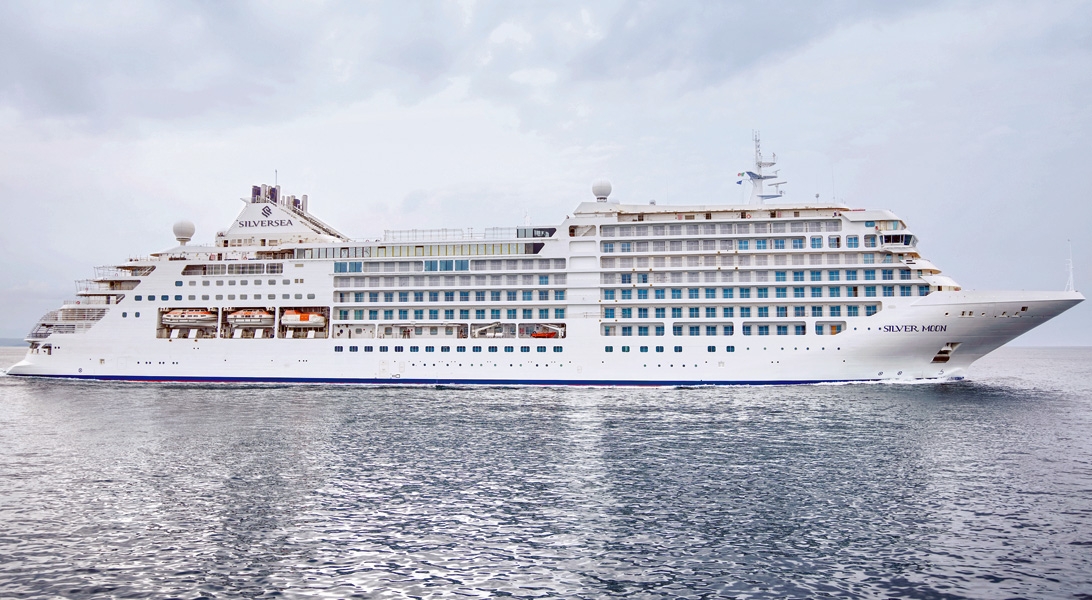








The images shown are for illustration purposes only and may not be an exact representation of what you find on the ship.
The images shown are for illustration purposes only and may not be an exact representation of what you find on the ship.
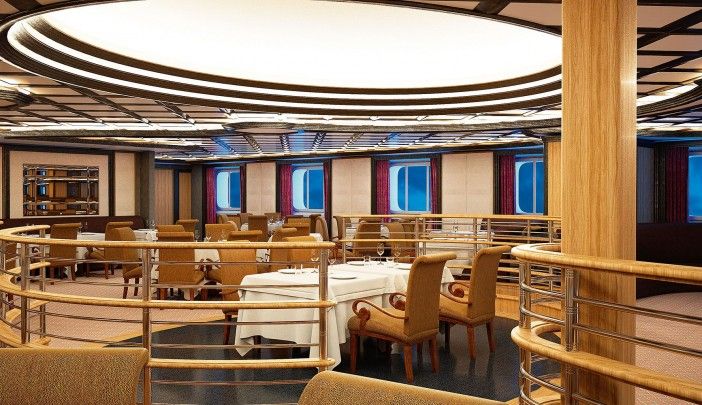
Instantly recalling images of the sea in all her watery majesty, the Atlantides are the seven nymph daughters of Atlas. Creative muses, known for their wisdom and beauty, the sisters were granted immortality in the form of stars and can be seen today in the constellation of Taurus. Pivotal to Silver Moon dining experience, this elegant bar and grill incorporates the best that the sea has to offer. Created to temper your taste buds, designer dishes such as royal crab, blue lobster and Verbena infused red snapper in a sea salt crust are showcased alongside the best steaks offshore.
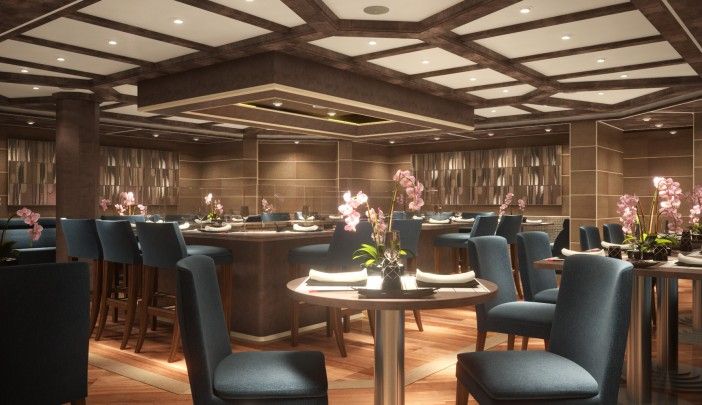
The fine art of Kaiseki lies in its meticulous preparation and beautiful presentation. Dishes reflect a passion for tradition and performance and our reinterpretation of these values is clear. Balanced menus have been inspired by the five elements of Japanese nutritional cuisine and respect the equilibrium of yin and yang. Daytime menus feature a varied and balanced menu of sushi, sashimi and other raw Asian-inspired dishes, while the evenings are alive with the taste and traditions of fine Japanese dining.
Per guest reservation fee of US$40.
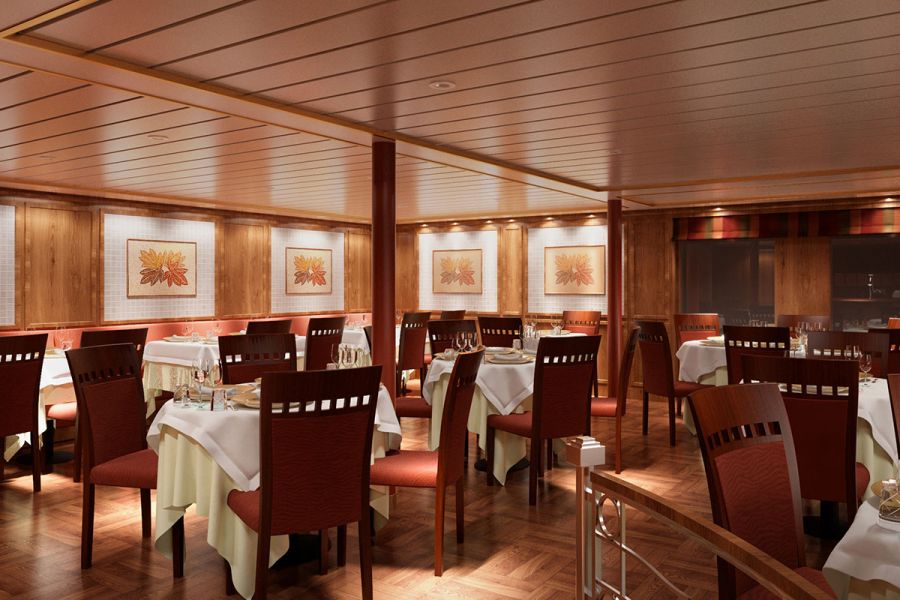
An iconic hallmark of Silversea dining, La Terrazza offers authentic recipes and the freshest ingredients from our distinctive Italian heritage. This is where antipasti, primi and secondi come together with passion and flair in a flavourful expression from corporate chef Alberto Colombo’s imagination. La Terrazza aboard Silver Moon offers innovative interactive food stations: an olive oil cellar, a mozzarella bar, a seafood station and of course a salumeria. The à la carte menu has also been extended to include the popular Sapori di Casa, traditional family-style Italian daily specials.
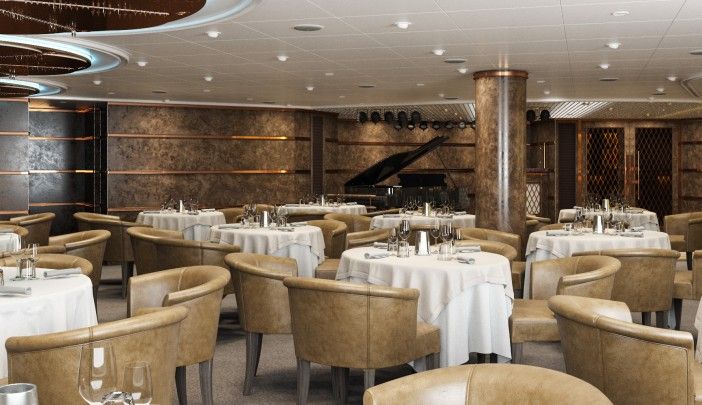
A sumptuous, intimate setting with a lively, joie de vivre ambience is the perfect place to dine, dance and dream the night away… Small plate tapas-style dishes of mouth-watering international cuisine perfectly compliment the rich, exciting entertainment as the smooth sounds of jazz and blues gently caress your ears. A refined late evening menu perfectly showcases the panache and style of Silver Moon's plentiful dining options, so expect multi-sensory fireworks as you swing and sway effortlessly across the dance floor as Silver Moon gracefully takes you to your next destination.
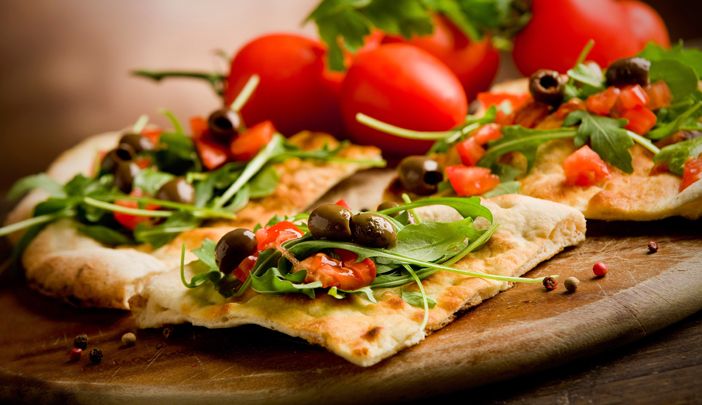
Reflecting Silversea’s Italian heritage, this emblematic street in Naples divides the city in two and is renowned for its pizzerias. No visit to the city is complete without a journey to Spaccanapoli. Therefore it is unsurprising that Spaccanapoli aboard Silver Moon reflects the true Italian way of life: the freshest ingredients, authentic dough and a perfect sense of the fabled Italian lust for life. The simplicity of la dolce vita is reflected in the relaxed dining style of the restaurant.
The images shown are for illustration purposes only and may not be an exact representation of what you find on the ship.
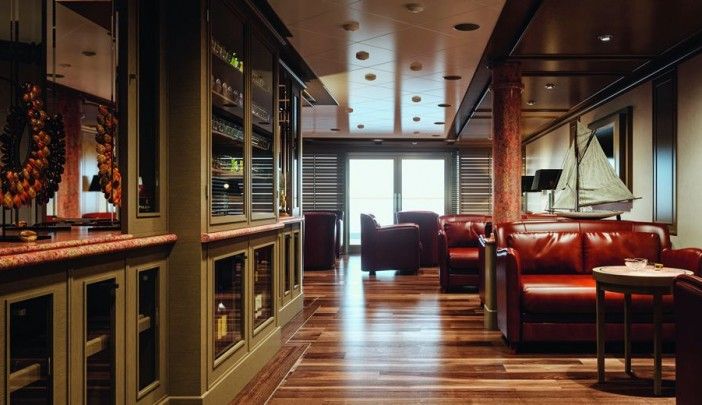
Rich and luxurious, yet airy and spacious, this indoor/outdoor venue is where you sip the finest cognac or whisky from a prestigious range and revel in the tranquil murmur of after-dinner conversation.
Our smoking lounge aboard Silver Moon is our latest venue where cigar-lovers can buy and sample some of the world’s finest Havanas, Cohibas, Partagás, Montecristos, Ramón Allones and Bolívars. Combining all the elements of cigar culture both indoors and on its stylish terrace, the Connoisseur’s Corner is where aficionados can meet and mingle to share their iconic passion.
Images are intended as a general reference. Features, materials, finishes and layout may be different than shown.
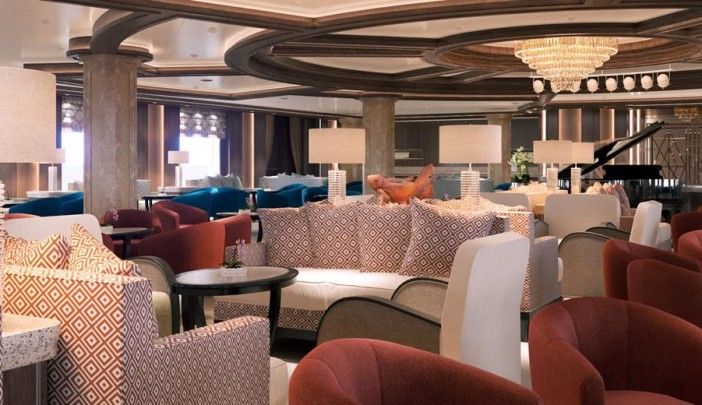
Dolce Vita is the gathering place for our savvy travellers of the world, a place where guests mingle and exchange stories and where new faces become lifelong friends.
Our main bar has been newly reimagined for Silver Moon! Dolce Vita has of course kept her legendary charm, inspired cocktails, stylish décor and comfortable seating, but a central bar now means the warm ambience is better than ever! Oozing Italian glamour, Dolce Vita is a relaxed, refined bar with a nightly piano player playing all your favourite tunes. Perfect for pre-dinner aperitivi, or even a post-dinner cocktail, Dolce Vita is truly the beating heart of social life on board.
Images are intended as a general reference. Features, materials, finishes and layout may be different than shown.
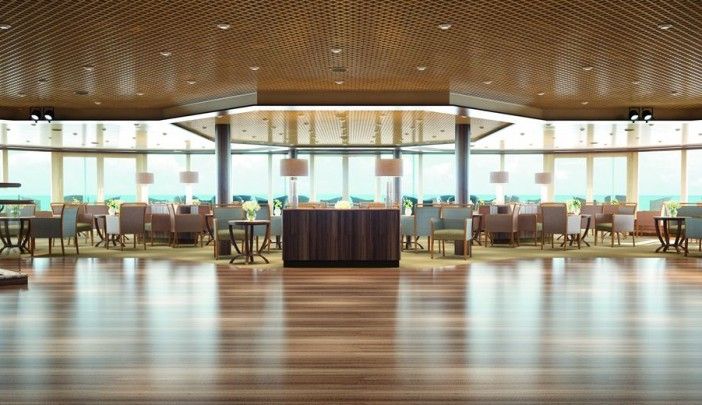
A peaceful retreat that is the perfect place to break away to, a social place to meet and greet old friends, or an evening venue to partake in a cocktail as you sit back and watch the world go by.
From early morning to late at night, the Panorama lounge offers everything you could wish for. A peaceful retreat that is the perfect place to break away to, a social place to meet and greet old friends, or an evening venue to partake in a cocktail as you sit back and watch the world go by. Sink into the plush seats and come evening, enjoy listening to the gentle sounds of a pianist, or the invigorating beats of our in-house DJ.
The images shown are for illustration purposes only and may not be an exact representation of what you find on the ship.
The images shown are for illustration purposes only and may not be an exact representation of what you find on the ship.
| 29 nights aboard the Silver Moon | |||
| Butler Service in Every Suite | |||
| Gratuities Always Included | |||
| Beverages In-Suite and Throughout the Ship | |||
| Gourmet Dining | |||
| In Suite Dining & 24-Hour Room Service | |||
| Intimate small size ships | |||
| Free Wifi Throughout the Ship | |||
| Free Zodiac, Land and Sea Tours & Activities & Complimentary Expedition gear | |||
| Port Taxes and Fees | |||
 | ABTA and ATOL Protection* | ||
Date 21st Mar 2025 |
Nts 29 |
Please Call for Availability |
Date 21st Mar 2025 |
Nts 29 |
Please Call for Availability |
| Suite staterooms |  | ||
| CV | Classic Veranda Suite |  | |
| DX | Deluxe Veranda Suite |  | |
| G1 | Grand Suite (1 Bedroom) |  | |
| G2 | Grand Suite (2 Bedrooms) |  | |
| O1 | Owner's Suite (1 Bedroom) |  | |
| O2 | Owner's Suite (2 Bedrooms) |  | |
| PA | Panorama Suite |  | |
| R1 | Royal Suite (1 Bedroom) |  | |
| R2 | Royal Suite (2 Bedrooms) |  | |
| S2 | Silver Suite (2 Bedrooms) |  | |
| SL | Silver Suite |  | |
| SV | Superior Veranda Suite |  | |
| VI | Vista Suite |  | |
Fusion Cruises when selling travel arrangements is a trading name of The Midcounties Co-operative Ltd. Fusion Cruises is an Accredited Body Member of Midcounties Co-operative Travel Consortium. (ABTA:P6652, ATOL:6053).
Book with Confidence. We are a Member of ABTA which means you have the benefit of ABTA’s assistance and Code of Conduct.
Some of the flights and flight-inclusive holidays on this website are financially protected by the ATOL scheme but ATOL protection does not apply to all holiday and travel services offered on this website. This website will provide you with information on the protection that applies in the case of each holiday and travel service offered before you make your booking. If you do not receive an ATOL Certificate then the booking will not be ATOL protected. If you do receive an ATOL Certificate but all parts of your trip are not listed on it, those parts will not be ATOL protected. Please see our booking conditions for information, or for more information about financial protection and the ATOL Certificate go to: www.caa.co.uk
